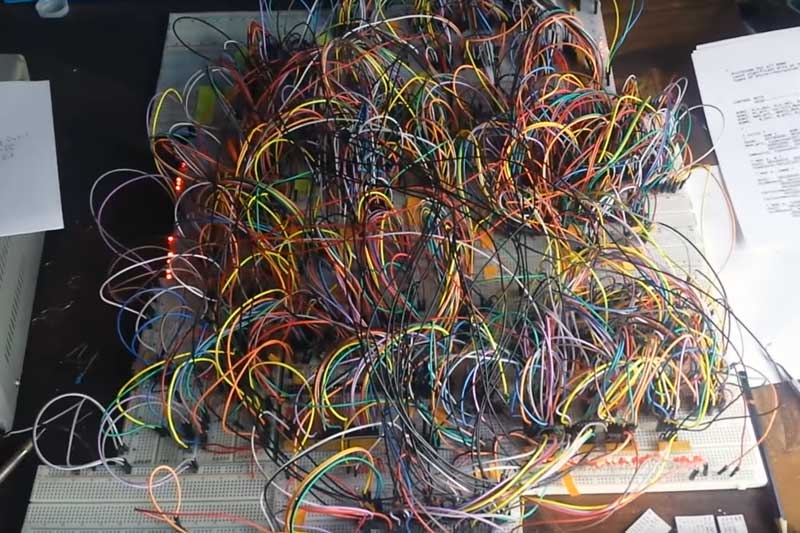It might look like a random pile of wires to some, but it is far from random: [Paulo Constantino] built this 8-bit CPU himself from scratch. He built his remarkable creation using wires and 74HC shift register chips, plus a selection of LEDs to show the various registers.
Running at a maximum of 5MHz, it has an 8-bit data and address bus, although the latter can be expanded to 16 bits. It’s not mining Bitcoin (yet), but it can do things like play the Mario theme. His latest addition is the addition of the ability to write data out to flash memory, and he is looking to add a keyboard to make programming easier.
At the moment, he has to program the CPU by setting DIP jumpers. It’s an impressive, if somewhat frightening build that [Paulo] says took him a couple of days to design and a week or so to build. We’ve seen a few breadboard CPU builds, (some of which were tidier) and builds with similar shift register chips, but this one scores big in the blinky light and mad genius stakes.
Thanks to [AnalogMind] for the tip!
















Could have done it with a 555 timer?
Could emulate on a PI zero and save space…
Hmm… I’m sure I had a box of mixed quarks around here somewhere I could use for this…
wow, congratulations. i’m going to go look for details.
Would be more impressive if the wires were all black ;-)
But seriously – cast it into epoxy and be done…
“AACK! One wire is loose!”
Enamelled copper wire
epoxy and ca have this nasty habit of wicking down the wire and insulating it from the contact, learned that the hard way
Are you sure that isn’t 5kHz?
Wow, the crosstalk has to be horrible.
Awesome! Reminds me of the backplanes on an old CPU rack. Just hope the cat doesn’t decide to pull a few wires!
Oh come on! It’s a several weeks til April 1st
God, it looks like 70’s porn!
All those wires and breadboard… the total parasitic capacitance probably reaches farad. Not pF, not uF, whole farad.
Considering the capacitance between two pins in a DIP is about the same as between two lanes in the breadboard, about 4 pf, I don’t think that’s such a big deal. The wires are far apart and will contribute diddly-squat to the capacitance. But the killer would rather be wonky contacts, with that many connections one of then are bound to go bad by just looking at them – especially if one is using cheap ebay/chinesium boards. I guess the inductance in the long wires would also be a bit problematic if you want nice clean & sharp edges on your signals.
Yeah, went through an amazing exercise many moons ago in school estimating stray capacitance and inductance of wire-wrapped circuits, and it was surprising.
The gist, as I recall, was that the big old rats’ nests of wire-wrapped connections that we often made were actually pretty solid performers. It was generally the length of the wire itself that was the chief limitation on speed, rather than various impedance and coupling issues.
Wire wrapped boards were space qualified for the Apollo project. You can’t get a better endorsement than that :-)
The chief speed limitation is the chips not the wiring on a small board like that. Remember electricity only takes a nano second to travel a foot of wire
Rubbish. It is now worse than a PCB with close track spacing.. You would need over a million miles of parallel cable to get a whole Farad
I Think I would leave out the C of CPU here :-D
It is an amazing work – I would go crazy with all theses wires
That is so cool.
Still amazed that he can get 5MHZ out of this. Fortunately the wires are all over the place and this probably helps overall.
Cool build!
if you are into this kind of thing, Ben Eater over on youtube has some great videos building an 8 bit cpu, https://www.youtube.com/channel/UCS0N5baNlQWJCUrhCEo8WlA
you could wear it as a hat!
or as a brooch!
I, for one, welcome our hairy CPU overlords.
ROFL +1
What? How?
How can this function? How was the cross-talk between the wires overcome? At 5MHz? I saw someone commented that might be a typo and was supposed to br 5KHz. Even at that frequency though… I’m amazed if this is real.
You don’t get much cross talk because wire runs are not parallel for any distance. I built several computers in the early eighties using wire wrapped rats nest backplanes and they ran happily at 20Meg.
@tangles: how about learning some electronics before wondering how it works ?
I would end up in OCD hell!
My breadboards randomly lose connections after days/weeks breaking the circuits. I often recommend against using them for longer-term prototyping for this reason. Is it just me?
That looks terrifying to debug. Wire-wrapping would be more reliable, but I don’t know if anyone still does that (and reliability probably isn’t the point of this build anyway.)
This guy really needs to work on his cable management skills. :D
I recently built a bit of test gear using a dozen TTL chips and I wire wrapped the whole project (except the power lines).. Comes a bit expensive but what price nostalgia :-)
I love your well-meaning comments DAVID. Thank you so much my friend. Bless you!
i bet this guy doesnt have a cat.
That’s one great whacking plate of spaghetti right there, and I want a fork…
,.,what? I’m hungry :P
The rats thank you for their new programmable nest…
Great job! Keep up the good work